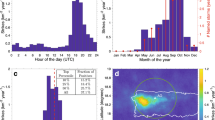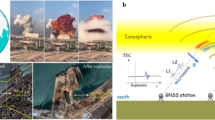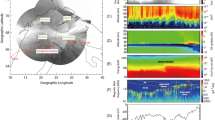Abstract
Tropospheric thunderstorms have been reported to disturb the lower ionosphere, at altitudes of 65–90 km, by convective atmospheric gravity waves1,2,3,4,5 and by electric field changes produced by lightning discharges6,7,8,9,10,11,12,13,14,15. Theoretical simulations suggest that lightning electric fields enhance electron attachment to O2 and reduce electron density in the lower ionosphere7,8. Owing to the low electron density in the lower ionosphere, active probing of its electron distribution is difficult16,17, and the various perturbative effects are poorly understood. However, it is now possible to probe the lower ionosphere in a spatially and temporally resolved manner by using remotely detected time waveforms of lightning radio signals4,5,18,19. Here we report such observations of the night-time ionosphere above a small thunderstorm. We find that electron density in the lower ionosphere decreased in response to lightning discharges. The extent of the reduction is closely related in time and space to the rate of lightning discharges, supporting the idea that the enhanced electron attachment is responsible for the reduction. We conclude that ionospheric electron density variations corresponding to lightning discharges should be considered in future simulations of the ionosphere and the initiation of sprite discharges.
This is a preview of subscription content, access via your institution
Access options
Subscribe to this journal
Receive 12 print issues and online access
$259.00 per year
only $21.58 per issue
Buy this article
- Purchase on Springer Link
- Instant access to full article PDF
Prices may be subject to local taxes which are calculated during checkout




Similar content being viewed by others
References
Taylor, M. J. & Hapgood, M. A. Identification of a thunderstorm as a source of short period gravity waves in the upper atmospheric night glow emissions. Planet. Space Sci. 36, 975–985 (1988).
Sentman, D. D. et al. Simultaneous observations of mesospheric gravity waves and sprites generated by a midwesterm thunderstorm. J. Atmos. Terr. Phys. 65, 537–550 (2003).
Davis, C. J. & Johnson, C. G. Lightning-induced intensification of the ionospheric sporadic E layer. Nature 435, 799–801 (2005).
Lay, E. H. & Shao, X-M. High temporal and spatial-resolution detection of D-layer fluctuations by using time-domain lightning waveforms. J. Geophys. Res. 116, A01317 (2011).
Lay, E. H. & Shao, X-M. Multi-station probing of thunderstorm-generated D-layer fluctuations by using time-domain lightning waveforms. Geophys. Res. Lett. 38, L23806 (2011).
Armstrong, W. C. Recent advances from studies of the Trimpi effect. Antarct. J. US 18, 281–283 (1983).
Taranenko, Y. N., Inan, U. S. & Bell, T. F. Interaction with the lower ionosphere of electromagnetic pulses from lightning: Heating, attachment, and ionization. Geophys. Res. Lett. 20, 1539–1542 (1993).
Pasko, V. P., Inan, U. S., Bell, T. F. & Taranenko, Y. N. Sprites produced by quasi-electrostatic heating and ionization in the lower ionosphere. J. Geophys. Res. 102, 4529–4561 (1997).
Inan, U. S., Pasko, V. P. & Bell, T. F. Sustained heating of the ionosphere above thunderstorms as evidenced in the early/fast VLF events. Geophys. Res. Lett. 23, 1067–1070 (1996).
Inan, U. S., Shafer, D. C., Yip, W. Y. & Orville, R. E. Subionospheric VLF signatures of nighttime D-region perturbations in the vicinity of lightning discharges. J. Geophys. Res. 93, 11455–11472 (1988).
Cheng, Z. & Cummer, A. S. Broadband VLF measurements of lightning-induced ionospheric perturbations. Geophys. Res. Lett. 32, L08804 (2004).
Mende, S. B. et al. D region ionization by lightning-induced electromagnetic pulses. J. Geophys. Res. 110, A11312 (2005).
Cheng, Z., Cummer, S. A., Su, H-T. & Hsu, R-R. Broadband very low frequency measurement of D region ionospheric perturbations caused by lightning electromagnetic pulses. J. Geophys. Res. 112, A06318 (2007).
Davis, C. J. & Lo, K-H. An enhancement of the ionospheric sporadic-E layer in response to negative polarity cloud-to-ground lightning. Geophys. Res. Lett. 35, L05815 (2008).
Han, F. & Cummer, S. A. Midlatitude nighttime D region ionosphere variability on hourly to monthly time scales. J. Geophys. Res. 115, A09323 (2010).
Thomson, N. R., Clilverd, M. A. & McRae, W. M. Nighttime ionospheric D region parameters from VLF phase and amplitude. J. Geophys. Res. 112, A07304 (2007).
Friedrich, M. & Rapp, M. News from the lower ionosphere: A review of recent developments. Surv. Geophys. 30, 525–559 (2009).
Jacobson, A. R., Shao, X-M. & Holzworth, R. Full-wave reflection of lightning long-wave radio pulses from the ionospheric D region: Numerical model. J. Geophys. Res. 114, A03303 (2009).
Shao, X-M. & Jacobson, A. R. Model simulation of very low frequency and low frequency lightning signal propagation over intermediate ranges. IEEE Trans. Electromagnet. Comput. 51, 519–525 (2009).
Shao, X-M. et al. Total lightning observations with the new and improved Los Alamos Sferic Array (LASA). J. Atmos. Oceanic. Technol. 23, 1273–1288 (2006).
Wiens, K. C., Hamlin, T., Harlin, J. & Suszcynsky, D. M. Relationships among Narrow Bipolar Events, total lightning, and radar-inferred convective strength in Great Plains thunderstorms. J. Geophys. Res. 113, D05201 (2008).
Cummer, S. A., Inan, U. S. & Bell, T. F. Ionospheric D-region remote sensing using VLF radio atmospherics. Radio Sci. 33, 1781–1792 (1998).
Shao, X-M., Jacobson, A. R. & Lay, E. H. Proc. XIV Int. Conf. on Atmospheric Electricity (International Commission on Atmospheric Electricity, 2011).
Jacobson, A. R., Shao, X.-M. & Lay, E. Time domain waveform and azimuth variation of ionospherically reflected VLF/LF radio emissions from lightning. Radio Sci. 47, RS4001 (2012).
Volland, H. (ed.) in Handbook Of Atmospheric Electrodynamics (CRC Press, 1995).
Shao, X-M., Lay, E. & Jacobson, A. R. On the behavior of return stroke current and the remotely detected electric field change waveform. J. Geophys. Res. 117, D07105 (2012).
Vadas, S. L., Yue, J., She, C-Y., Stamus, P. A. & Liu, A. Z. A model study of the effects of winds on concentric rings of gravity waves from a convective plume near Fort Collins on 11 May 2004. J. Geophys. Res. 114, D06103 (2009).
Mach, D. M., Blakeslee, R. J., Bateman, M. G. & Bailey, J. C. Comparisons of total currents based on storm locations, polarity, and flash rates derived from high-altitude aircraft overflights. J. Geophys. Res. 115, D03201 (2010).
Lyons, W. A. et al. Upward electrical discharges from thunderstorm tops. Bull. Am. Meteorol. Soc. 84, 445–454 (2003).
Rodger, C. J. et al. Lightning-driven inner radiation belt energy deposition into the atmosphere: Implications for ionisation-levels and neutral chemistry. Ann. Geophys. 25, 1745–1757 (2007).
Acknowledgements
This research was supported by the Los Alamos National Laboratory by Laboratory Directed Research and Development project 20110184ER. We thank P. Colestock and J. Zinn for useful discussions on air chemistry.
Author information
Authors and Affiliations
Contributions
X-M.S. drafted the manuscript, developed the ground-wave model and integrated it with the ionosphere reflection model, and supervised the project. E.H.L. analysed the lightning data, compared the data with the model and derived the electron profiles from the comparisons. A.R.J. developed and improved the ionosphere reflection model. All authors contributed to the discussion of the results and the preparation of the manuscript.
Corresponding author
Ethics declarations
Competing interests
The authors declare no competing financial interests.
Rights and permissions
About this article
Cite this article
Shao, XM., Lay, E. & Jacobson, A. Reduction of electron density in the night-time lower ionosphere in response to a thunderstorm. Nature Geosci 6, 29–33 (2013). https://doi.org/10.1038/ngeo1668
Received:
Accepted:
Published:
Issue Date:
DOI: https://doi.org/10.1038/ngeo1668
This article is cited by
-
Evaluation of the performance of the World Wide Lightning Location Network (WWLLN) using the lightning detection network (LINET) as a truth
Bulletin of Atmospheric Science and Technology (2023)
-
Survey of electron density changes in the daytime ionosphere over the Arecibo Observatory due to lightning and solar flares
Scientific Reports (2021)
-
Significant Day-time Ionospheric Perturbation by Thunderstorms along the West African and Congo Sector of Equatorial Region
Scientific Reports (2020)
-
Locating Parent Lightning Strokes of Sprites Observed over a Mesoscale Convective System in Shandong Province, China
Advances in Atmospheric Sciences (2018)
-
A review of advances in lightning observations during the past decade in Guangdong, China
Journal of Meteorological Research (2016)



